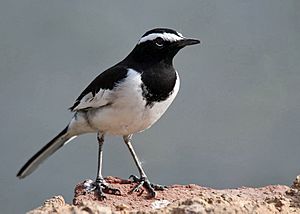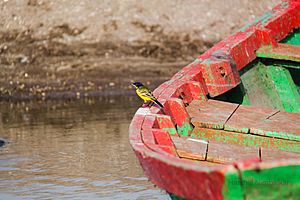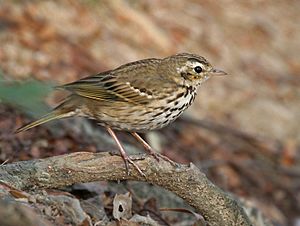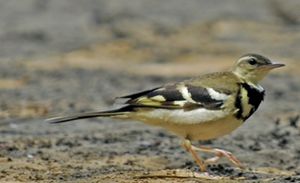Motacillidae facts for kids
Quick facts for kids Motacillidae |
|
|---|---|
 |
|
| White-browed wagtail (Motacilla maderaspatensis) | |
| Scientific classification |
|
| Kingdom: | Animalia |
| Phylum: | Chordata |
| Class: | Aves |
| Order: | Passeriformes |
| Superfamily: | Passeroidea |
| Family: | Motacillidae Horsfield, 1821 |
| Genera | |
|
|
The wagtails, longclaws, and pipits are a group of small passerine birds. They belong to the family called Motacillidae. These birds usually have medium to long tails.
There are about 70 different kinds (species) of these birds, found in 5 main groups (genera). Longclaws live only in Africa. Wagtails are mostly found in Europe, Africa, and Asia. Two types of wagtails even travel to and breed in Alaska. Pipits live almost everywhere in the world. You can find them in the Old World (Europe, Asia, Africa), the Americas, and on islands like New Zealand and the Falklands. Some scientists sometimes put two African species, the yellow-breasted pipit and Sharpe's longclaw, into a separate group called Hemimacronyx. This group is closely related to the longclaws.
Most birds in the Motacillidae family eat insects they find on the ground. They like open areas. They live in many different places, from beaches to high mountains. Wagtails prefer places that are a bit wetter than where pipits live. A few species, like the forest wagtail, live in forests. Others, like the grey wagtail or mountain wagtail, live near mountain streams in wooded areas.
These birds eat many kinds of small creatures without backbones. Insects are their main food. They also eat spiders, worms, and small water snails. What they eat most often depends on what is available in their local area.
Most Motacillids build their nests on the ground. They lay up to six speckled eggs. The only exception is the forest wagtail, which nests in trees.
What Do Motacillids Look Like?
Wagtails, pipits, and longclaws are slim birds. They are small to medium-sized, usually 14 to 17 centimeters long. They have short necks and long tails. Their legs are long and pale, with long toes and claws. The claw on their back toe can be very long, up to 4 centimeters in some longclaws!
Male and female birds of the same species are usually the same size. Longclaws are generally bigger and stronger than pipits and wagtails. A longclaw can weigh up to 64 grams. Pipits and wagtails usually weigh between 15 and 31 grams.
Most pipits have dull brown feathers, similar to larks. However, some pipits, like the golden pipit from northeast Africa, have brighter colors. Adult male longclaws often have brightly colored undersides. Wagtails often have very noticeable feathers, with colors like grey, black, white, and yellow.
Motacillid Species and Groups
Here are some of the different types of birds in the Motacillidae family:




Family: Motacillidae
- Genus Dendronanthus
- Forest wagtail, Dendronanthus indicus
- Genus Motacilla: These are the typical wagtails.
- Western yellow wagtail, Motacilla flava
- Eastern yellow wagtail, Motacilla tschutschensis
- Citrine wagtail, Motacilla citreola
- Cape wagtail, Motacilla capensis
- Madagascar wagtail, Motacilla flaviventris
- Grey wagtail, Motacilla cinerea
- Mountain wagtail, Motacilla clara
- White wagtail, Motacilla alba
- Pied wagtail, Motacilla alba yarrellii
- Black-backed wagtail, Motacilla alba lugens
- African pied wagtail, Motacilla aguimp
- Mekong wagtail, Motacilla samveasnae
- Japanese wagtail, Motacilla grandis
- White-browed wagtail, Motacilla madaraspatensis
- São Tomé shorttail Motacilla bocagii
- Genus Tmetothylacus
- Golden pipit, Tmetothylacus tenellus
- Genus Macronyx: These are the longclaws.
- Cape longclaw, Macronyx capensis
- Yellow-throated longclaw, Macronyx croceus
- Fülleborn's longclaw, Macronyx fuellebornii
- Sharpe's longclaw, Macronyx sharpei - sometimes placed in genus Hemimacronyx
- Abyssinian longclaw, Macronyx flavicollis
- Pangani longclaw, Macronyx aurantiigula
- Rosy-throated longclaw, Macronyx ameliae
- Grimwood's longclaw, Macronyx grimwoodi
- Genus Anthus: These are the typical pipits.
- Richard's pipit Anthus richardi
- Paddyfield pipit Anthus rufulus
- Australian pipit Anthus australis
- New Zealand pipit Anthus novaeseelandiae
- African pipit Anthus cinnamomeus
- Mountain pipit Anthus hoeschi
- Blyth's pipit Anthus godlewskii
- Tawny pipit Anthus campestris
- Long-billed pipit Anthus similis
- Nicholson's pipit Anthus nicholsoni
- Wood pipit Anthus nyassae
- Buffy pipit Anthus vaalensis
- Plain-backed pipit Anthus leucophrys
- Long-legged pipit, Anthus pallidiventris
- Meadow pipit Anthus pratensis
- Tree pipit Anthus trivialis
- Olive-backed pipit Anthus hodgsoni
- Pechora pipit Anthus gustavi
- Rosy pipit Anthus roseatus
- Red-throated pipit Anthus cervinus
- Buff-bellied pipit Anthus rubescens
- Water pipit Anthus spinoletta
- European rock pipit Anthus petrosus
- Nilgiri pipit Anthus nilghiriensis
- Upland pipit Anthus sylvanus
- Berthelot's pipit Anthus berthelotii
- Striped pipit Anthus lineiventris
- African rock pipit Anthus crenatus
- Short-tailed pipit Anthus brachyurus
- Bushveld pipit Anthus caffer
- Sokoke pipit Anthus sokokensis
- Malindi pipit Anthus melindae
- Yellow-breasted pipit Anthus chloris - sometimes placed in genus Hemimacronyx
- Alpine pipit Anthus gutturalis
- Sprague's pipit Anthus spragueii
- Yellowish pipit Anthus lutescens
- Short-billed pipit Anthus furcatus
- Pampas pipit Anthus chacoensis
- Correndera pipit Anthus correndera
- South Georgia pipit Anthus antarcticus
- Ochre-breasted pipit Anthus nattereri
- Hellmayr's pipit Anthus hellmayri
- Paramo pipit Anthus bogotensis
- Madanga, Anthus ruficollis
See also
 In Spanish: Motacílidos para niños
In Spanish: Motacílidos para niños


